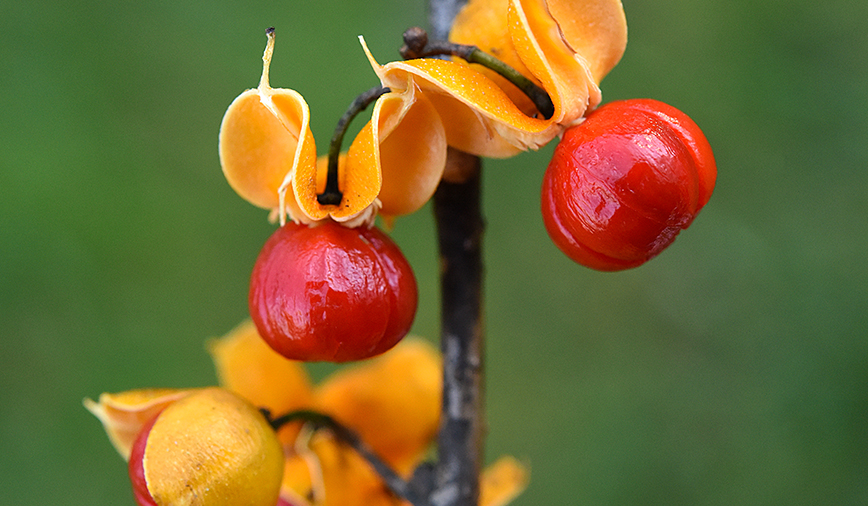December 6, 2013 Bittersweet
Readers of this column have no doubt noticed, I’m not much of a plant person. Sure, I can point out our
more notable natives, and I can lament non-native buckthorn, honeysuckle and garlic mustard with the best of ’em. But for the most part I feel better leaving the commentary on our local flora to folks more qualified than I.
However, every once in a while, a plant-related issue pops up that even I can’t ignore. Sometimes the topic is timely, sometimes it’s controversial. This week, though, it’s bittersweet.
Oriental bittersweet, that is: Celastrus orbiculatus.
A common component in holiday floral arrangements, this Asian vine with colorful berries is popping up all over Kane County—not just in decorative swags and centerpieces, but also our yards, parks and natural areas. Like a distant relative who came for Thanksgiving and is now camped out on your sofa, Oriental bittersweet is the guest that will not leave.
Although it resembles its native counterpart American bittersweet, C. scandens, Oriental bittersweet differs in many significant ways. For one, its berries grow from the leaf axils of the vine and are strung out along the stems; the fruit of American bittersweet, by contrast, grows only at the ends of its branches. (Easy ways to remember these differences, courtesty of the Minnesota Department of Agriculture and UMN Extension: “Strung
out is bad,” and “Save the best for last.”)
Further, Oriental bittersweet fruit is surrounded by yellow seed capsules that pop open when ripe, while American bittersweet capsules are orange. (Another memory-helper: “Yell when you see Yellow, but Orange is Okay.”)
But probably the biggest differences between these two forest vines are their growing habits. American bittersweet grows vigorously, yet behaves. It doesn’t blanket its surrounding landscape and smother everything in sight.
Oriental bittersweet, by contrast, has the capacity to strangle every tree and shrub it encounters. Its twisting vines can reach more than 60 feet in length, with additional shoots popping up as the roots spread. Allowed to grow unchecked, the plant can engulf a woodland’s canopy layer and shade out the trees and herbaceous plants below. What’s more, its weight, when accompanied by winter’s snow and ice, can cause branches to break and trunks to snap.
When you see a woodlot that’s been overtaken by Oriental bittersweet, you may be inclined to ask, “What the…? Where is this stuff coming from?”
As is so often the case with introduced species, the very qualities that make Oriental bittersweet such a pernicious invader are the same traits that once made it attractive to gardeners here in the New World. Introduced as an ornamental nearly 300 years ago, C. orbiculatus thrives in a variety of soils and growing conditions and produces prodigious quantities of fruit.
That fruit, which admittedly is kinda pretty, is really the root of the problem. Birds feed on the berries and then inadvertently distribute the seeds, which then germinate and start to grow.
Besides wildlife, humans are also to blame, since so many of us buy and transport the vines. Even
though several states now regulate the sale of Oriental bittersweet (Illinois is not one of them) it’s not
hard to find vines for sale on the internet. A quick Google search brought up several ads for recently harvested C. orbiculatus; sellers promise vines “full of berries” and offer to ship “anywhere in the United States.”
Ugh.
This time of year, lots of folks are “decking” their halls, not just with boughs of holly but also with vines
of bittersweet. Before you hang that wreath or garland with the lovely orange berries, do yourself, your neighbors and your environment a big favor and doublecheck your “decks.”
Use the accompanying photo to identify whether your arrangement contains Oriental bittersweet. If so,
please don’t hang it up outside. More than a few of those berries are sure to drop into the soil, where a
new vine will then result.
Use care indoors too. When the holidays are over and all the trimmings come down, be sure to bag any bittersweet you’re tossing in the trash, and tie it up tight. Burning the vines might be an even better option, provided you can make sure every last berry goes up in flames. In short, take every precaution you can to make sure those decorations become only a bittersweet memory.
Pam Otto is the manager of nature programs and interpretive services at the Hickory Knolls Discovery Center, a facility of the St. Charles Park District. She can be reached at 630-513-4346 or potto@stcparks.org.

